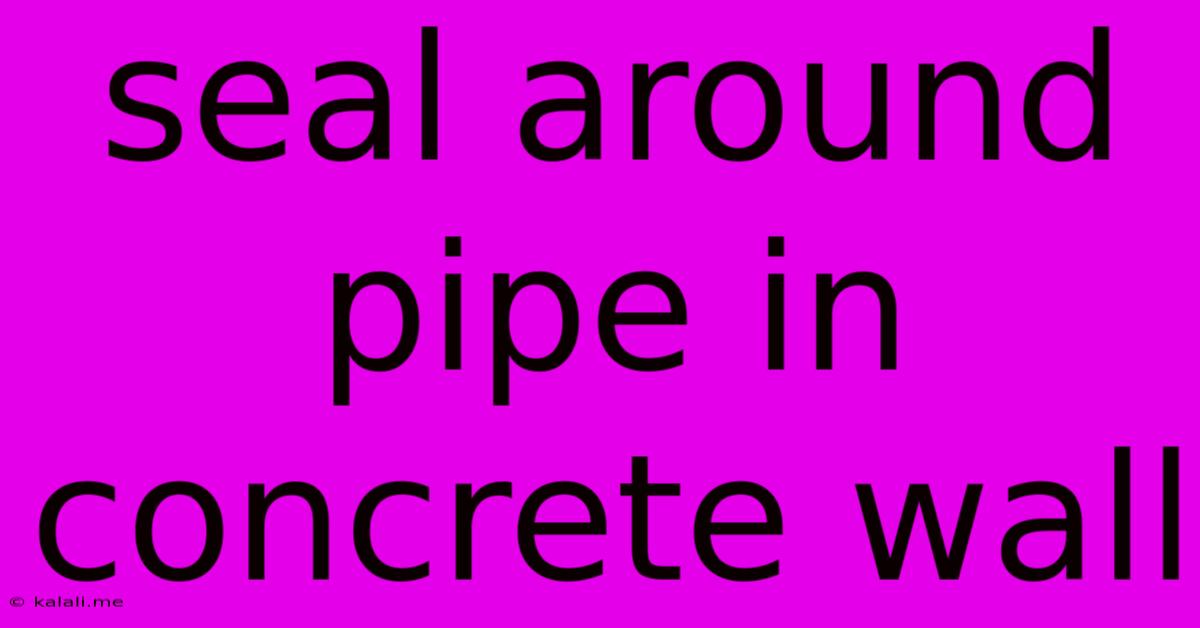Seal Around Pipe In Concrete Wall
Kalali
Jun 05, 2025 · 3 min read

Table of Contents
Sealing Around Pipes in Concrete Walls: A Comprehensive Guide
Sealing around pipes penetrating concrete walls is crucial for preventing leaks, water damage, and structural compromise. This guide details effective methods and best practices to ensure a durable and watertight seal, improving the longevity and integrity of your structure. Whether you're tackling a DIY project or overseeing a professional installation, understanding these techniques is vital.
Why Proper Sealing is Essential
Ignoring proper sealing around pipes embedded in concrete walls can lead to several significant problems:
- Water Damage: Leaks around pipes can cause significant water damage to the surrounding concrete and internal structures, leading to costly repairs and potential structural weakening. This is especially important in areas prone to moisture or freezing temperatures.
- Mold and Mildew Growth: Persistent dampness encourages the growth of mold and mildew, posing health risks to occupants and further damaging building materials.
- Structural Weakness: Continuous exposure to water weakens the concrete, creating cracks and compromising the structural integrity of the wall.
- Pest Infestation: Gaps around pipes can provide entry points for insects and rodents, leading to infestations and further damage.
Choosing the Right Sealant
The choice of sealant depends on several factors, including the pipe material, the environment, and the desired level of durability. Consider these options:
- Caulk: A readily available and relatively inexpensive option, suitable for smaller gaps and less demanding applications. However, caulk may not be durable enough for high-pressure situations or extreme temperature fluctuations.
- Epoxy: A strong and versatile adhesive offering excellent water resistance and durability. Epoxy is ideal for larger gaps and high-pressure applications, providing a long-lasting seal.
- Hydraulic Cement: A specialized cement designed for underwater applications, offering exceptional waterproofing properties. Ideal for situations where significant water pressure is anticipated.
- Silicone Sealant: Known for its flexibility and excellent adhesion to various materials, silicone sealant is suitable for applications involving movement or vibration.
Step-by-Step Sealing Process
The precise steps may vary depending on the sealant chosen and the specific situation, but a general process includes:
- Preparation: Clean the area around the pipe thoroughly, removing any loose debris, old sealant, or rust. Ensure the surface is dry and free of dust or contaminants to ensure proper adhesion.
- Application: Apply the sealant according to the manufacturer's instructions. For caulk, use a caulking gun; for epoxy, mix the components thoroughly before applying. Ensure complete coverage of the gap between the pipe and the concrete.
- Smoothing: Smooth the sealant to create a seamless transition between the pipe and the concrete. This helps prevent water from accumulating and penetrating the seal.
- Curing: Allow the sealant to cure completely before exposing it to water or significant stress. Refer to the manufacturer's instructions for the curing time.
- Inspection: After curing, inspect the seal for any imperfections or gaps. Address any issues promptly to prevent future problems.
Advanced Techniques and Considerations
- Sleeve and Seal: For larger pipes or critical applications, consider using a pipe sleeve before applying sealant. This provides added protection and enhances the seal's durability.
- Expansion Joints: In areas prone to expansion and contraction, incorporate expansion joints to accommodate movement and prevent seal failure.
- Professional Installation: For complex situations or critical applications, it's best to consult a professional plumber or contractor to ensure a proper and lasting seal.
By following these guidelines, you can effectively seal around pipes in concrete walls, preventing water damage, preserving structural integrity, and protecting your investment. Remember, choosing the right sealant and following proper application techniques are key to achieving a durable and watertight seal.
Latest Posts
Latest Posts
-
Can A Bad Egr Valve Cause A P0300 Code
Jun 06, 2025
-
Why Are Police Dogs Called K9
Jun 06, 2025
-
How Hot Is A Wood Fire
Jun 06, 2025
-
Where Can I Identify Electrical Compoennets
Jun 06, 2025
-
Dwarf Fortress Providing An Object To A Dwarf
Jun 06, 2025
Related Post
Thank you for visiting our website which covers about Seal Around Pipe In Concrete Wall . We hope the information provided has been useful to you. Feel free to contact us if you have any questions or need further assistance. See you next time and don't miss to bookmark.